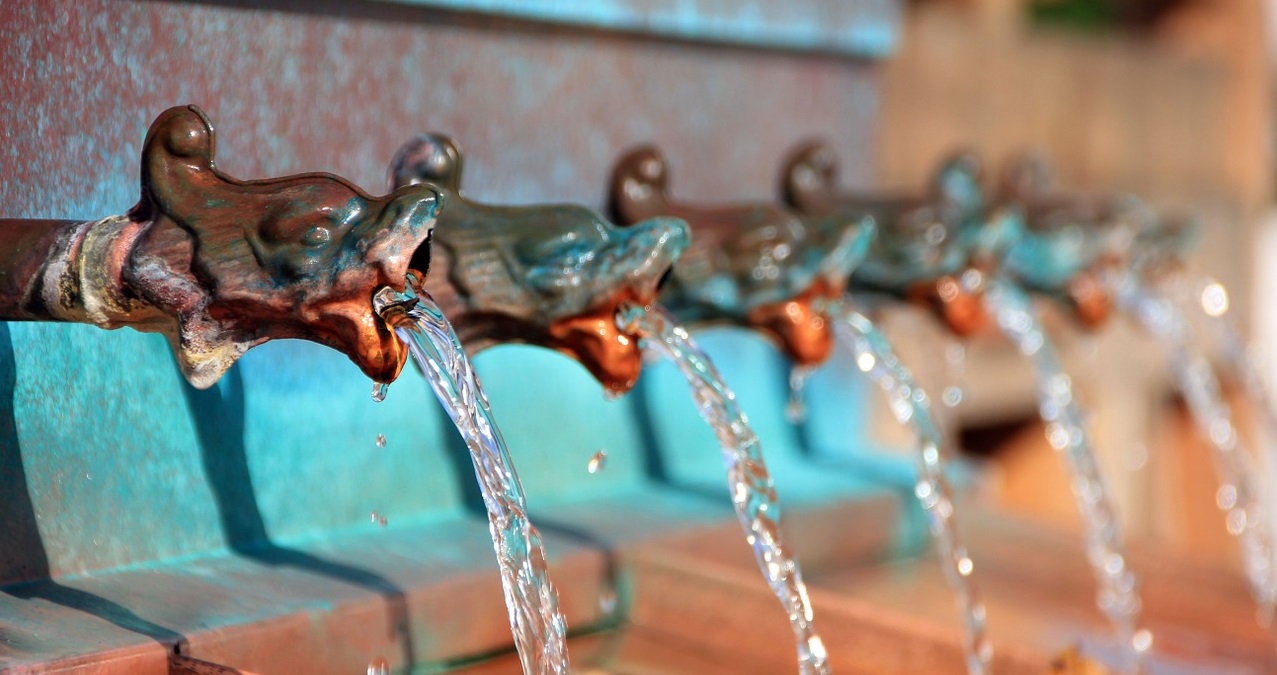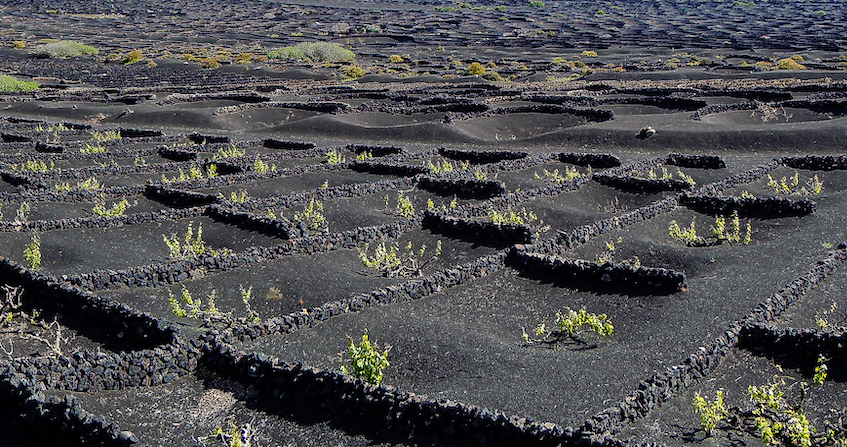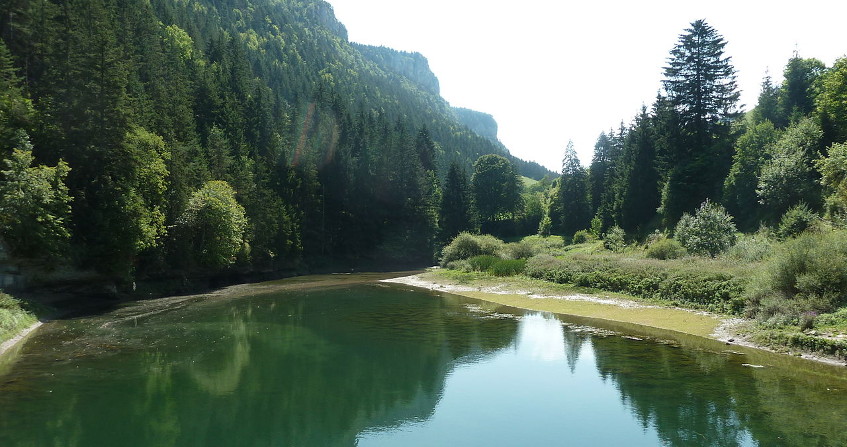Plants water needs
PDF
Water is essential for plant growth. If there is a lack of rainwater -particularly in the perspective of climate change- what can man do to ensure the plant production necessary for his food? There are two possibilities that can be combined: (i) provide the necessary additional water via irrigation and/or (ii) adapt the choices of crops and cultivation practices to the possibilities of the environment. In the first case, he will have to take into account the local availability of water resources and the compatibility of his withdrawal with other uses of aquifers and watercourses. In the second case, he will have to focus his efforts to adapt his farming techniques the lack of water wich is, the weak link in his farming system. This will lead him to accept a decrease in production to make it compatible with the potential of the environment.
1. Evapotranspiration, a doubly necessary process
To grow, plants – whether cultivated or not – need water. Indeed, to fix the carbon necessary for photosynthesis, the pores located on the surface of the leaves, called stomata, must be open. This allows carbon dioxide from the air to enter the leaf and be transformed into sugars (see Shedding light on photosynthesis & The path of carbon in photosynthesis).
This opening of the stomata puts the water constituting the tissues in contact with the air and causes its evaporation.[1]

Evapotranspiration is therefore a necessary loss of water for all vegetation. For a surface covered by vegetation (Figure 2), this evapotranspiration is the sum of:
- water vapor transpired by plants through stomata (noted Tr) ;
- direct evaporation from the soil (noted E) which is generally low compared to Tr.
The evapotranspired water comes from the soil explored by the roots. The soil is supplied with water by rain. If the surface is slightly sloped, some of the rainwater may run off. If the soil moisture is above a threshold called “field capacity”, the excess water percolates down, replenishing the water table (or aquifer). Between two rains events, the soil moisture decreases. If the soil becomes too dry, the plants reduce their transpiration, and thus the ETa, and this corresponds to the situation of the deficit pot in Figure 1.

This consumption of 2/3 of the rain by evapotranspiration is not only useful for the production of vegetation (and the associated carbon storage!), it is also absolutely essential for a climatic reason. Indeed, the change of state of the liquid water in the cell tissues towards the vapor water of the atmosphere is performed through a consumption of heat, called latent heat. This one is substantial since it takes 600 calories per gram of evaporated water (2,4 10⁶ J/Kg) (see Focus Transpiration and heat protection). On an annual scale, this represents an energy consumed equivalent to 2/3 of the radiation balance of all wavelengths. This allows us to have a temperate climate in contrast with desert regions which have summer temperatures above 40°C. This is more evident today with the occurrence of heat wave droughts that accompany climate change!
In summary, the evapotranspiration of 2/3 of the rain is essential for plant production and climate.
2. How can we meet the water needs of plants?
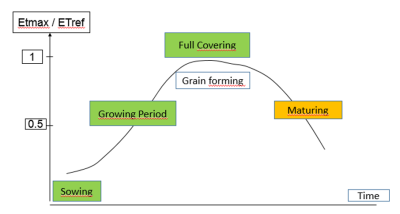
Relative to this reference, any plant cover will be subject to a demand, called ETmax, which depends on its soil covering (named leaf aera index) and stage of development (Figure 3).
For example, in May, the ETmax demand will be high for a covering winter wheat crop, whereas it will be low for a corn crop that is just emerging from the soil. Conversely, in July, the demand will be low on a yellowed wheat field ready to harvest, while it will be high on a fully covering green corn field. [4]
Facing this demand, what is the supply? This supply does not correspond to the day’s rainfall, but to the accumulation of rainfall from previous periods that has soaked the soil: supply is the availability of water in the soil.
For supply and demand to correspond, there are two possibilities:
- Artificially adding water if the local climate is not sufficient to provide the soil with enough water: this is the approach that mobilizes part of the “blue” water to irrigate.
- Choosing crops adapted to the local climate and/or adopting techniques that make better use of rainwater in the context of rain-fed agriculture.
3. Matching supply to demand: irrigation
3.1. Irrigation in France
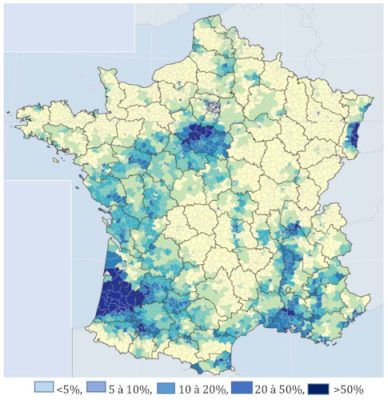
The total irrigated surface in France is slightly more than 15,000 km2, i.e. the equivalent of 3 departments (excluding the Paris region). It is possible to define 3 zones (Figure 4):
- The South-East quarter, with a Mediterranean climate, where the quantity of water supplied is around 400 mm/year;
- The vast western region, known as the “Atlantic banana”, stretching from the Pyrenean foothills to Ile-de-France. It alone represents 4/5 of the irrigated surface and the quantities of water brought in are of the order of 150 to 200 mm/year;
- A last residual group, of a more continental nature (Limagne, the Rhone valley and especially the Alsace plain which is the least watered region in France due to the Foehn effect caused by the Vosges)
At the scale of the French territory, with an average quantity of irrigation water increased to 300 mm, we observe that this corresponds to 1% of the annual rain (300 mm = 1/3 of the rainfall; 15,000 km2 = 3% of the metropolitan territory). Thus, unlike more southerly countries, irrigation in France is not a national problem. On the other hand, it is a serious regional problem in certain parts of the territory, especially in the southwest. Where does this come from?
3.2. irrigation mode and irrigation logic
There are three types of irrigation (Figure 5): sprinkler, furrow and drip.
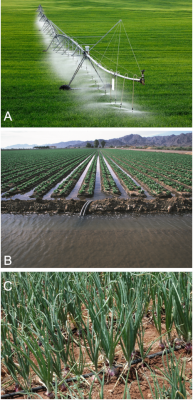
There are two irrigation logics: reservoir logic and flow logic. This depends on the size of the aquifers used:
- The reservoir logic for large aquifers (e.g. the Beauce water table: 9000 km2), whose half-decay time is greater than 6 months. This makes it possible to be interested only in the multiannual variation of the water table level by accepting seasonal variations. In this case, it is necessary that the combination of cultivation systems in the region allows this multiannual level not to decrease. This has led to a reduction in the percentage of irrigated corn in Beauce to about 20% of the total area.
- The logic of flow for small aquifers or the water tables accompanying rivers (basically the whole of France except for the Paris Basin) whose response time is less than 3 months. In this case, it is not only the quantity of water withdrawn that is important, but also the time of year when it is withdrawn, because the flow of rivers at low water must be maintained above a threshold necessary for water quality and other uses.
However, it is during the dry period that spring crops are fully covering and need water. For example, corn [6], a plant of tropical origin that does not consume more water overall than any other, but only develops if the weather is warm. For the regions south of the Loire, it is not only the low water level period but also the time of the year when the arrival of tourists take place and considerably. The problem is particularly acute in the southwest. Indeed, while the South-East has an abundance of exogenous water (Bas-Rhône canal in Languedoc, Canal de Provence), the left bank of the Garonne can only count on the Neste canal (with a flow twice as small) and the region of the former Poitou-Charente does not have any (the Deux-Sèvres department, however northern, and the two Charentes are those where conflicts of use are the most acute)
3.3. What crops are irrigated?
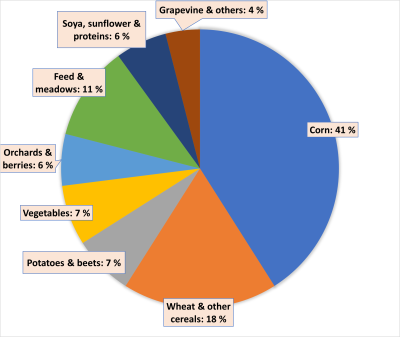
Corn does not consume more water than other crops, but unlike crops from Mediterranean or temperate regions (wheat and other winter crops), it has its peak consumption and sensitivity to stress towards the end of July, in the middle of the dry and low water period.
Today, the share of irrigated winter cereals is increasing for reasons of yield regularity and grain quality.
3.4. How will the situation evolve with climate change?
From an agrometeorological point of view, what is important is not rainfall alone but the potential balance: Rainfall – Atmospheric Demand (ETref)
Figure 7 shows a comparison of this balance (in mm H2O) measured at the end of the 20th century (left-hand map) with what a climate model (“Arpège” of the French National Meteorological Office) simulated for the near future (2020-2050, center map) and for the end of this 21st century (right-hand map) in the “Climator” project [9].
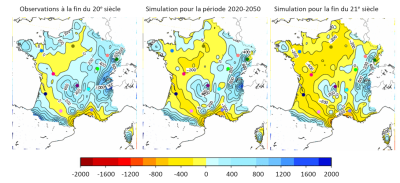
This is likely to exacerbate the problem of shortage of water for irrigation for 3 reasons:
- The decrease in summer rainfall (higher occurrence of heat wave droughts already observed) will lead to reductions in water stock in the soil during the vegetation period;
- This reduction of water in the soil under all vegetation, cultivated or not, will lead to a decrease of water restitution to the water tables. This will lead to a decrease in “blue” water, and therefore in the flow of rivers used in summer for irrigation;
- Finally, a point rarely mentioned: the increase in temperature will lengthen the growing season. This will increase the total water requirements of the late varieties that will be planted or the double cropping that some are considering.
3.5. What are the prospects?
There are two ways of dealing with a shortage of irrigation water (intrinsic shortage or shortage linked to competition from other water uses):
- Improving irrigation efficiency through the choice of efficient equipment and/or a better knowledge of plant needs. These two approaches are well underway. For example, software exists that enables farmers to better distribute water during the growing season. However, this approach will not be sufficient.
- Manage crop rotation in irrigated agriculture (i.e. the choice of crops to be grown) according to water resources. For example, further reduce the area cultivated with corn by developing the cultivation of sorghum, a plant that is a “cousin” of corn but more easily drought tolerant. Thus, sorghum can be satisfied with partial irrigation, in places where corn needs total irrigation.
To go further if the resource becomes scarce, we must address the second aspect, i.e. reconsider irrigation, by reducing the irrigated areas in favor of rain-fed agriculture adapted to drought.
4. Adapting demand to supply: rain-fed agriculture
When rainfall is not abundant, there are two ways to match supply and demand: improve rainfall efficiency and/or reduce water demand.
4.1. Improving rainfall efficiency
Only a fraction of rainwater is transpired, i.e., useful for photosynthesis: that which infiltrates into the soil to feed the roots. Increasing this effective rainfall for the farmer is therefore a true question.
Various techniques are used, such as weeding the gardens, which reserves the water in the soil for the cultivated crop. The most widespread technique is a component of conservation agriculture that reduces runoff. Although runoff contributes partially to aquifers, it has the double disadvantage of reducing infiltration and causing soil erosion. In conservation agriculture, it is recommended not to plough and to leave the crop residues on the ground. Various experiments (on millet, maize and sorghum in dry areas) have reported reductions in runoff of more than 50% in the presence of residues, whether or not the soil is plaughed.
4.2. Decreased demand in dry periods
- Winter crops
Some crops are problematic because they have their peak consumption in dry periods. As we have seen, corn does not consume more water than any other crop (it takes about 500 mm of water for the cycle of a crop or any other vegetation) but it has its peak water consumption in the middle of summer. Reducing water stress in the dry period means favoring crops that consume most of their water outside this period. These are the so-called “winter crops” that are sown in the fall and harvested in early summer (wheat and most crops in our regions). They develop for temperatures slightly higher than 0°C. Their cycle is regulated on the correspondence in temperate zone between cold season and wet season). Plants of tropical origin (corn, millet, sorghum and other C4 metabolisms) only develop if the temperature is strongly higher than 0°C (about 7 or 8°C), hence the need to sow them only in April or May which leads them to grow strongly in dry periods: it is their thermal need which is at the origin of their hydric problem here.
It is therefore necessary to favour “winter crop” species which, better adapted to our climate, “dodge” the drought.
- Dodging
This “dodging” can also play a role within the same species. Indeed, most often, drought arrives at the end of the cycle, putting late varieties at risk compared to early varieties. The producer must therefore make a strategic choice at the time of sowing: to grow early varieties with lower potential but not very prone to drought or late varieties with higher production potential but at risk of being penalized by drought.
- Avoidance
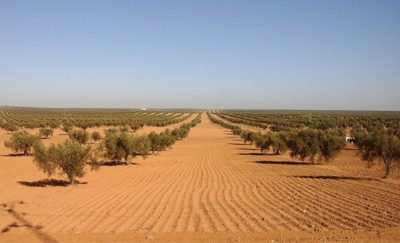
Avoidance can be natural or agronomic: for example, a tree subjected to a summer drought loses its leaves before autumn to protect itself (natural avoidance), or a person who buys a potted plant to plant it in the ground “cuts back” the foliage to give the roots time to become functional (agronomic avoidance). Pruning fruit trees is aerial agronomic avoidance.
Avoidance can be below ground: sorghum is better adapted to drought than corn, not only because it is not prone to fruit abortion (that is drought tolerance) but also because it is better rooted. An established alfalfa plant with roots up to 2 m deep is very resistant to drought (natural avoidance).
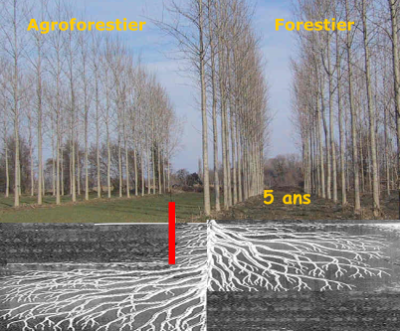
- Agroforestry
Another way to increase the rooting of trees can be agroforestry. Thus, Dupraz and Gosme (Figure 9) [10 ] compared the depths of walnut trees cultivated either in traditional orchards or in widely spaced rows, where wheat was grown every year (this is an example of agroforestry where an annual plant – in this case wheat – is associated with a perennial plant – in this case walnut – which will be harvested in 10, 20 or even 30 years). The consumption of water by the wheat annually dries out the 1m deep soil layer leading the 5 year old walnut to install its roots deeper (3 m instead of 1.5 m in orchard) and thus making it more likely to resist occasional drought.
5. Messages to remember
- The evapotranspiration of plants is necessary for their growth and for the mildness of the climate: – It corresponds roughly to 2/3 of the yearly rain (it is the “green” water);
– It corresponds roughly to 2/3 of the rain (this is the “green” water); 1/3 of the rain remains for other uses (this is the “blue” water);
- The atmospheric demand for water is about 6 mm/d in good spring and summer weather;
- If rainwater is insufficient, one can either irrigate or adapt the choice of crops and techniques;
- Irrigation concerns 3% of the French territory and consumes 1% of the rainwater (i.e. 3% of the “blue” water) but locally poses problems of competition for use (especially in the southwest);
- Corn is the most irrigated crop, but its share of total water consumption has begun to decrease;
- Corn does not consume more water than other crops but has its peak consumption in summer;
- Climate change will exacerbate the pressure on water in the summer (increased demand for atmospheric water and reduced “blue” water resources);
- Crop diversity allows for better water management;
- Rainfed agriculture can be implemented by:
- Improving the efficiency of rainfall (conservation agriculture);
- Choosing adapted crops (winter crops, early crops, better rooted crops);
- Implementing adequate cultivation techniques (plant spacing, pruning);
- Encouraging the rooting of trees (agroforestry).
Notes & References
Cover image. Olive trees with yellow sky and sun by Vincent Van Gogh (1889), The Minneapolis Institute of Arts, public domain. [Source: Vincent van Gogh, Public domain, via Wikimedia Commons]
[1] An exception: cacti and other C.A.M plants that open their stomata at night, storing CO2 that they will photosynthesize during the day and collecting any dew. These desert plants have a very low annual growth.
[2] François Tardieu, ESCO Sécheresse restitution symposium. Paris October 2006
[3] On the concepts of blue water and green water: https://appgeodb.nancy.inra.fr/biljou/fr/fiche/eau-verte-eau-bleue
[4] Note that for all types of cover, the ratio peaks at around 1. This means that, whatever the cover (cereals, grassland, forest), daily evapotranspiration will not exceed the 6 mm dictated by the available radiation energy. Of course, this is true for an extensive canopy and not for a hedge, which captures much more radiation per unit area on the ground.
[5] Service de la Statistique et de la Prospective du Ministère de l’Agriculture
[6] It is also a C4 plant which is said to have a better photosynthetic water efficiency than C3 plants.
[7] Maize is itself 50% irrigated, little in the north and Ile de France, and almost totally irrigated in the Landes.
[8] https://agreste.agriculture.gouv.fr/agreste-web/download/publication/publie/ChdAgr216/ChdAgr216.pdf
[9] Final report of the Climator project (2007-2010)
[10] Dupraz C. & Gosme M., Functional plasticity and adaptation to climate change: the case of Mediterranean agroforestry systems – Session of the French Academy of Agriculture, 5 November 2014
The Encyclopedia of the Environment by the Association des Encyclopédies de l'Environnement et de l'Énergie (www.a3e.fr), contractually linked to the University of Grenoble Alpes and Grenoble INP, and sponsored by the French Academy of Sciences.
To cite this article: ITIER Bernard (August 18, 2023), Plants water needs, Encyclopedia of the Environment, Accessed October 25, 2024 [online ISSN 2555-0950] url : https://www.encyclopedie-environnement.org/en/life/plants-water-needs/.
The articles in the Encyclopedia of the Environment are made available under the terms of the Creative Commons BY-NC-SA license, which authorizes reproduction subject to: citing the source, not making commercial use of them, sharing identical initial conditions, reproducing at each reuse or distribution the mention of this Creative Commons BY-NC-SA license.





